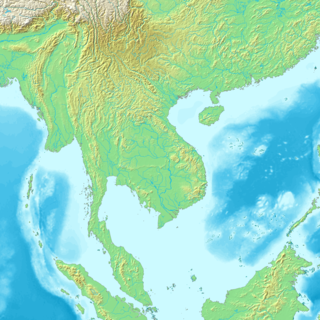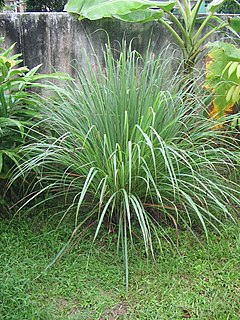
Myanmar is the northwesternmost country of mainland Southeast Asia. It lies along the Indian and Eurasian Plates, to the southeast of the Himalayas. To its west is the Bay of Bengal and to its south is the Andaman Sea. It is strategically located near major Indian Ocean shipping lanes. The neighboring countries are China, India, Bangladesh, Thailand and Laos.

Mainland Southeast Asia is the continental portion of Southeast Asia. It lies east of the Indian subcontinent and south of China and is bordered by the Indian Ocean to the west and the Pacific Ocean to the east. It includes the countries of Cambodia, Laos, Myanmar (Burma), Peninsular Malaysia, Thailand and Vietnam.

Cymbopogon, also known as lemongrass, barbed wire grass, silky heads, Cochin grass, Malabar grass, oily heads or fever grass, is a genus of Asian, African, Australian, and tropical island plants in the grass family. Some species are commonly cultivated as culinary and medicinal herbs because of their scent, resembling that of lemons . The name cymbopogon derives from the Greek words kymbe and pogon "which mean [that] in most species, the hairy spikelets project from boat-shaped spathes."

The Burma campaign was a series of battles fought in the British colony of Burma. It was part of the South-East Asian theatre of World War II and primarily involved forces of the Allies; the British Empire and the Republic of China, with support from the United States. They faced against the invading forces of Imperial Japan, who were supported by the Thai Phayap Army, as well as two collaborationist independence movements and armies, the first being the Burma Independence Army, which spearheaded the initial attacks against the country. Puppet states were established in the conquered areas and territories were annexed, while the international Allied force in British India launched several failed offensives. During the later 1944 offensive into India and subsequent Allied recapture of Burma the Indian National Army, led by revolutionary Subhas C. Bose and his "Free India", were also fighting together with Japan. British Empire forces peaked at around 1,000,000 land and air forces, and were drawn primarily from British India, with British Army forces, 100,000 East and West African colonial troops, and smaller numbers of land and air forces from several other Dominions and Colonies.

The South-East Asian Theatre of World War II was the name given to the campaigns of the Pacific War in Burma, India, Thailand, the Philippines, Indochina, Malaya and Singapore.
The Mara are the native inhabitants of Mizoram in India, native to northeastern India, primarily in the Mara Autonomous District Council of the state of Mizoram, where they form the majority of the population. The Maras are related to Kuki and Mizos in India and Kachin, Karen, Shan and Chins in Myanmar. Significant numbers of Maras are also found living south-western and south-central part of Chin State (Burma), in Myanmar - the contiguous area of Mara area in India mostly separated by Kolodyne / Chhimtuipui / Beino river, which forms an international boundary. They were earlier known as the Lakher by outsiders as Tlaikao/Lushai called them by that name and as Zochhia by the Lai and Shendu by the Khumi people, Dai people, Shô people, Matu people, and Rakhaing, and the new name Mara was inserted in List of Scheduled Tribes in Mizoram state in 1978 replacing the old name. The Maras were in early period known to the outside world under different tribal names such as Mara, Lakher, Shendu, Magha, Miram, Baungshel or Shendoo, Maring, Zyu or Zao/Zho, Khuangsai, etc. They constitute a distinct tribal group lying in Siaha / Saiha district of Mizoram, while also occupying northern part of Paletwa township and Matupi township, Western and Southern part of Thlantlang township, Southern part of Haka township. They called themselves "Maras".

The Chin Hills are a range of mountains in Chin State, northwestern Burma (Myanmar), that extends northward into India's Manipur state.

A South Asian pickle, known as achar, aachar, athanu or achaar, is a pickled food, native to the Indian subcontinent, made from a variety of vegetables and fruits, preserved in brine, vinegar, or edible oils along with various Indian spices.

Charles Thomas Bingham was an Irish military officer and entomologist.

Digama is a genus of moths in the family Erebidae described by Frederic Moore in 1858. It is distributed in South Africa, China, throughout India, Sri Lanka, Myanmar and Australia.

The Japanese invasion of Burma was the opening phase of the Burma campaign in the South-East Asian theatre of World War II, which took place over four years from 1942 to 1945. During the first year of the campaign, the Japanese Army drove British Empire and Chinese forces out of Burma, then began the Japanese occupation of Burma and formed a nominally independent Burmese administrative government.

The Burmese ferret-badger, also known as the large-toothed ferret-badger, is a mustelid native to Southeast Asia.

The Asian Socialist Conference (ASC) was an organisation of socialist political parties in Asia that existed between 1953 and 1965. Until 1963 its headquarters was in Rangoon, Burma; the first chairman and treasurer of the conference were the Burmese socialist leaders Ba Swe and Kyaw Nyein respectively. As of 1956, the member parties of ASC had a combined membership of about 500,000. In total, four Asian Socialist Conferences convened: Rangoon, 1953 and 1954, and Bombay, 1956 and 1965.
Digama burmana is a moth of the family Erebidae. It is found in Myanmar.
Digama fasciata is a moth of the family Erebidae described by Arthur Gardiner Butler in 1877. It is found in north-western India and Sri Lanka.
Digama hearseyana is a moth of the family Erebidae described by Frederic Moore in 1859. It is found in India, Nepal, Sri Lanka and Pakistan. Two subspecies are recognized.
Digama insulana is a moth of the family Erebidae described by Rudolf Felder in 1868. It is found in India, Sri Lanka and Vietnam.
Digama meridionalis is a moth of the family Erebidae first described by Charles Swinhoe in 1907. It is found in much of southern and eastern Africa.
Makury, or Makury Naga, is a Naga language of India and Burma. Shi (2009:3) and Saul (2005:25) suggest that Makury may be an Ao language.











